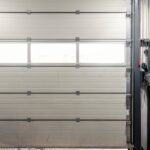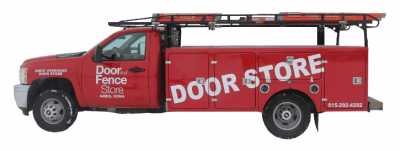Garages wouldn’t function without a tenacious motor in place. Many companies focus on garage door styles rather than the motor that drives them. If you don’t have much information about garage door motors, read on to learn everything you need to know to select the right motor for your company’s facility.
What Are DC Motors?
Direct Current (DC) motors are one of the two primary types of motors used in garage door systems. DC motors operate by converting electrical energy into mechanical energy. The direct current creates a continuous flow of electricity. The unidirectional power and non-fluctuating voltage produce a quieter, more efficient operation.
DC motors also allow for precise control over door opening and closing speeds. When you need to make specific adjustments based on your business procedures, the ability to alter the speed can come in handy.
What Are AC Motors?
Alternating Current (AC) motors are simplistic electric devices that have two basic parts: the outside stator and the inside rotor. The outside stator generates a rotating magnetic field, while the inside rotor produces a second rotating magnetic field. The interaction between these two fields creates rotation.
AC motors are highly durable and capable of handling high starting currents, making them well-suited for garage doors. However, they are not as efficient as their DC counterparts; they can emit more noise during operation, and it is difficult to manage the garage door speed. Nevertheless, they are a popular choice that’s favorable for garage door systems.
The Importance of Horsepower
Horsepower refers to the power output of a motor; it must supply enough power to lift and lower the door. Commercial garage doors feature industrial metals that are extremely heavy. Therefore, the motor must have incredibly high horsepower to operate properly.
A motor with inadequate horsepower may struggle to lift heavier doors, leading to strain, reduced motor life, and potential system failure. Higher horsepower contributes to the longevity of the motor by reducing strain.
It’s important to remember that having more horsepower than required can be an unnecessary expense. It’s beneficial to seek professional guidance to determine the appropriate horsepower for your specific garage door system.
The Different Types of Openers
There are four main types of garage door openers: chain drive, screw drive, belt drive, and direct drive. Understanding the distinctive characteristics of each type can help you make more informed decisions when selecting an opener that aligns with your specific business requirements.
- Chain Drive Openers: Chain drive openers are common styles that use a chain to push and pull a trolley and move the door. They are generally inexpensive, reliable, and offer excellent lifting power. However, the metal-to-metal contact in the chain can lead to relatively noisy operations.
- Screw Drive Openers: Screw drive openers operate with a threaded steel rod that moves the trolley. This system has fewer moving parts than other designs and requires less maintenance.
- Belt Drive Openers: Instead of a chain, these openers use a belt—typically made of rubber, polyurethane, or steel-reinforced rubber—to move the trolley. Belt drive openers offer quiet and smooth operation, making them a great choice for commercial establishments where noise could be an issue. However, they tend to be pricier than either chain drive or screw drive openers.
- Direct Drive Openers: Direct drive openers, often referred to as jackshaft openers, feature a motor that moves along a stationary chain. Most businesses mount this opener on the wall next to the garage door. It offers quiet operation and has fewer moving parts, which can result in less maintenance. However, these openers can be more expensive than traditional types.
The Driving Force Behind the Motor
A signal from one of two primary interfaces for user interaction often initiates the garage door’s operation, whether from a remote control or a wall-mounted switch. These devices send a specific code to the receiver unit integrated into the garage door motor. The receiver interprets the code and triggers the motor to either lift or lower the door, depending on the signal received.
Additionally, modern garage doors may also incorporate Wi-Fi, allowing the door to be operated via a smartphone app. The garage door operates due to a seamless combination of user interaction, electronic communication, and the intricate mechanical and electrical components of the door motor system.
Security Features in Commercial Garage Door Motors
Commercial garage door motors come with a range of security features designed to protect properties from unauthorized access and ensure the safe operation of the door. The following are some of the key security features the motors include.
- Automatic door reversal causes the door to reverse its direction if it encounters an obstacle while closing. It prevents potential damage to vehicles and safeguards against injuries to individuals who might be in the door’s path.
- Manual release option is a precautionary function that occurs in case of a power outage or motor failure. This release allows you to manually open or close the garage door, ensuring the door remains accessible during unforeseen situations.
- Lock mode disables remote access when activated. This mode can be particularly useful during extended periods of inactivity or during non-operational hours to prevent unauthorized entry.
- Timer-to-close automatically closes the garage door after a preset time, ensuring the door won’t unintentionally remain open for extended periods.
How Will You Choose Your Next Garage Door?
When you understand everything you need to know about garage motors, you can start thinking about which components are necessary to precisely fit your garage and business. Use the following tips as you make your decision.
- Consider the type of metal you prefer for the garage door. Steel and aluminum are two of the best materials on the market for security and durability purposes.
- Take into account the weight and size of the door. These factors will determine the amount of horsepower you’ll need for the motor.
- Choosing an insulated garage door will encourage energy efficiency. The facility will maintain indoor temperatures while reducing energy costs. Insulation is especially beneficial for cold storage facilities.
- Keep your budget in mind before deciding the type of garage door and motor you will need. It’s still possible to purchase a high-quality garage door at a good price.
Every component of a garage door affects how the door will operate. Fortunately, industrial garage doors from the Door and Fence Store use high-quality materials that will withstand thousands of cycles and tough weather conditions while protecting each employee at work.









